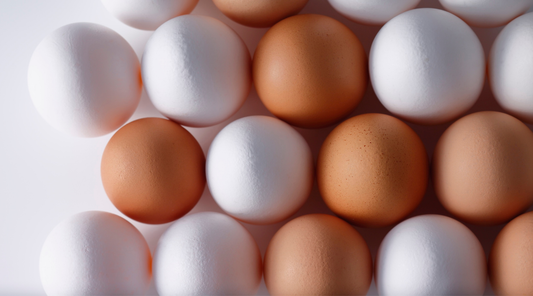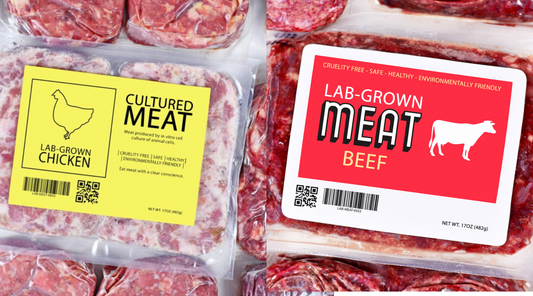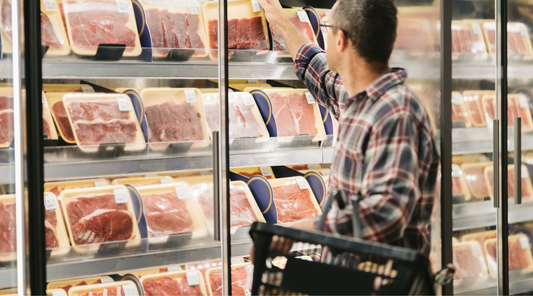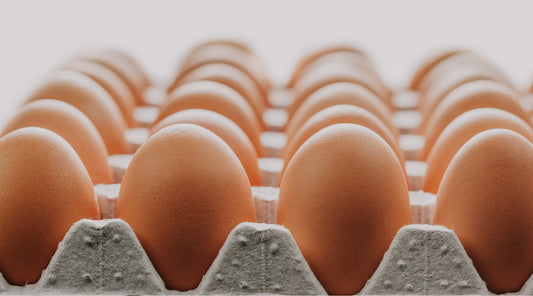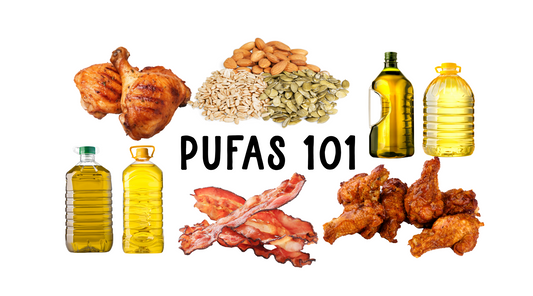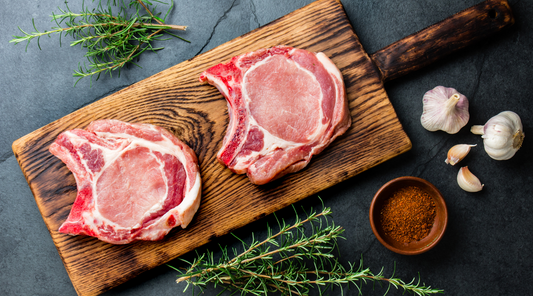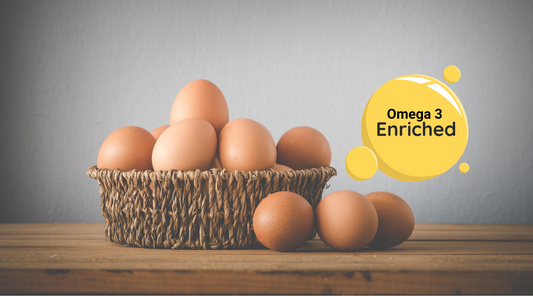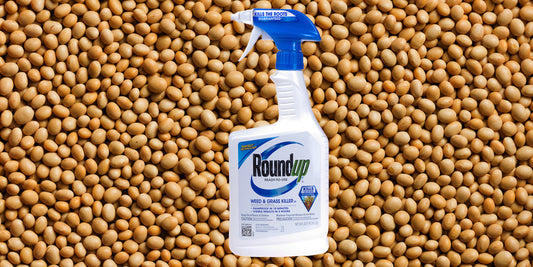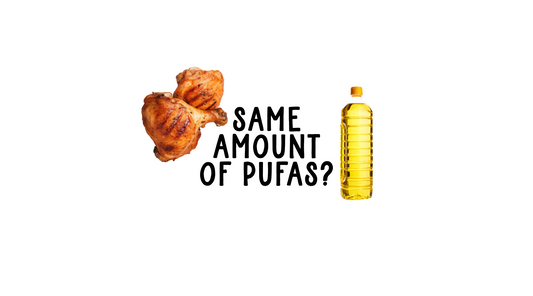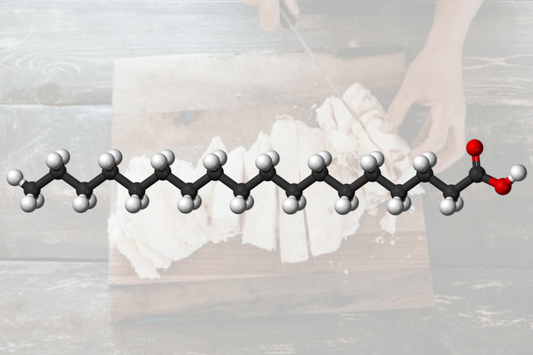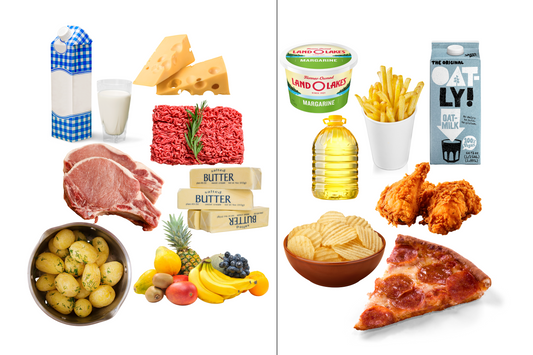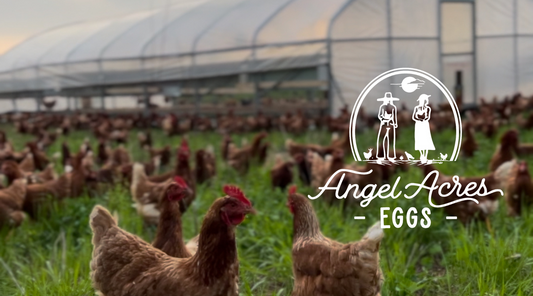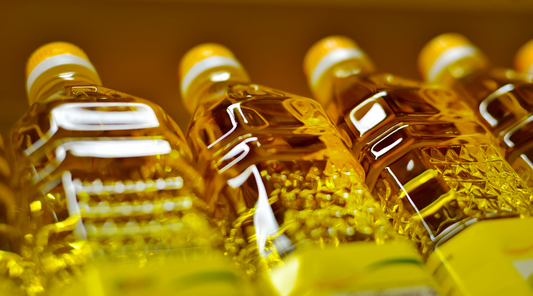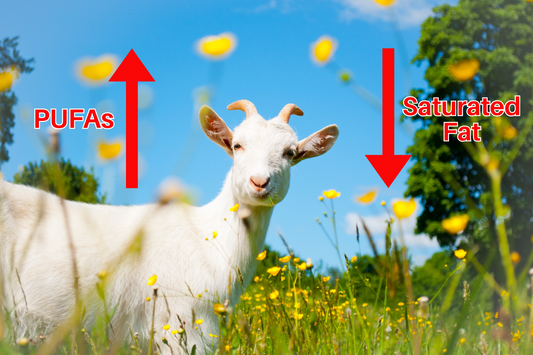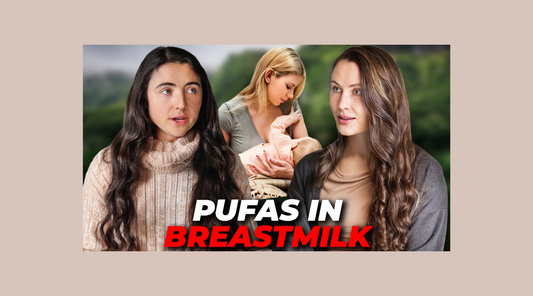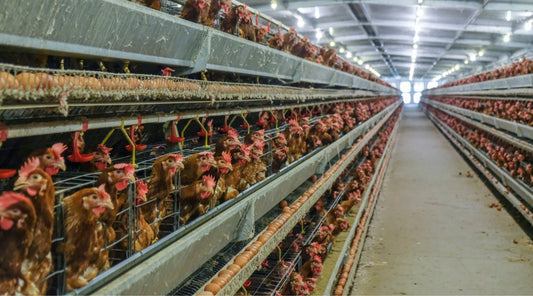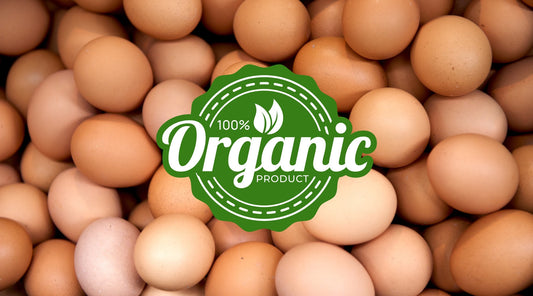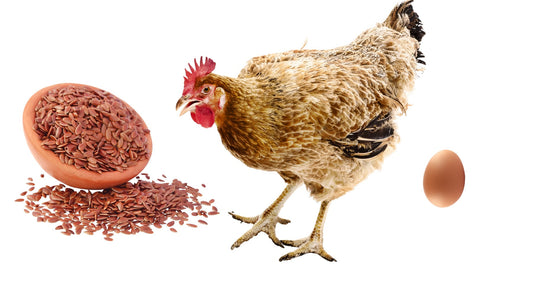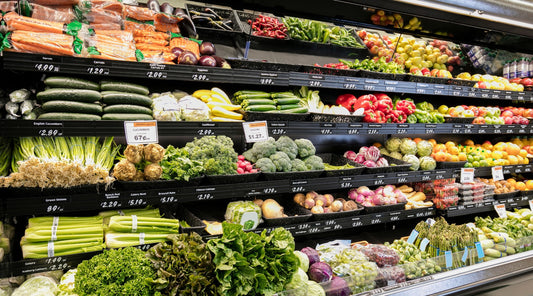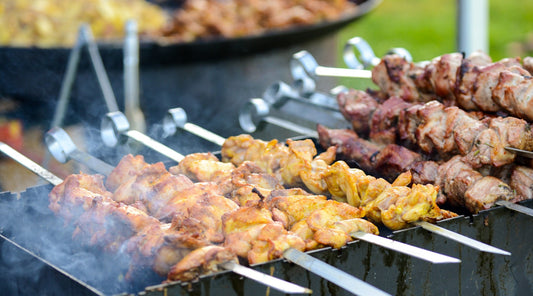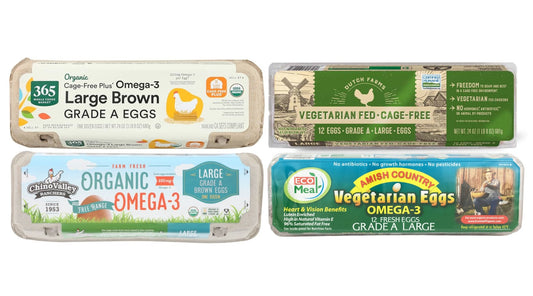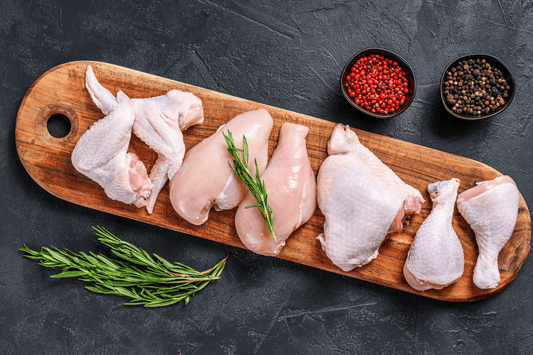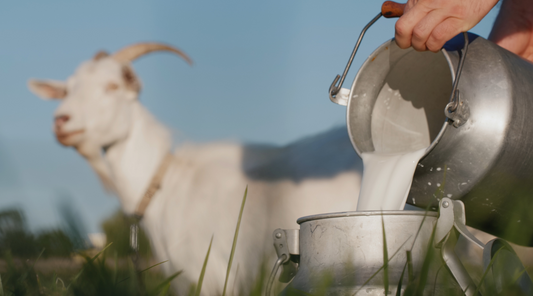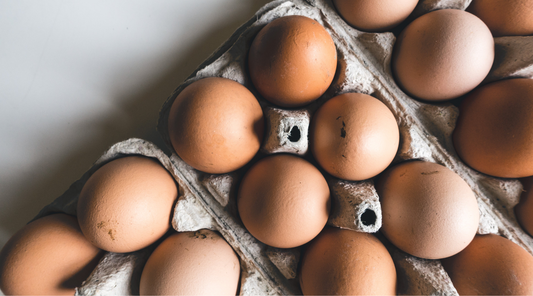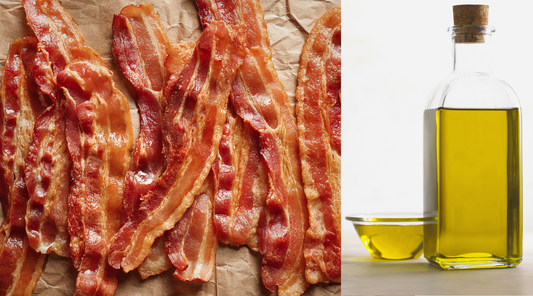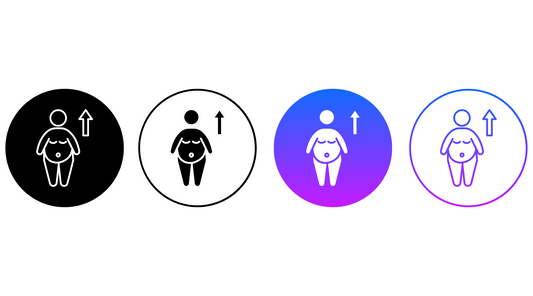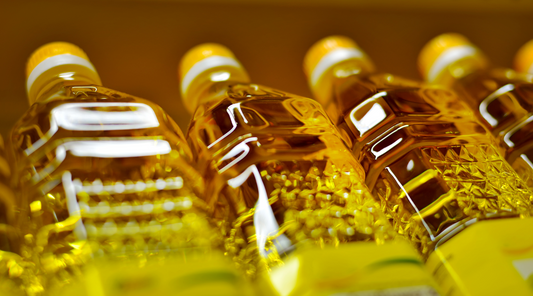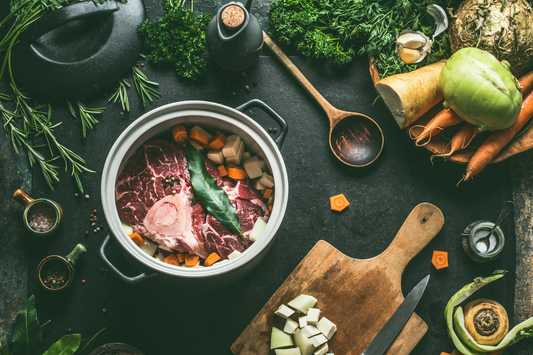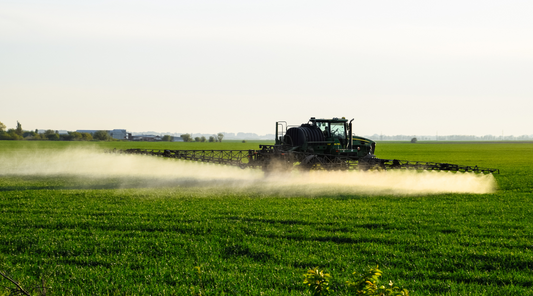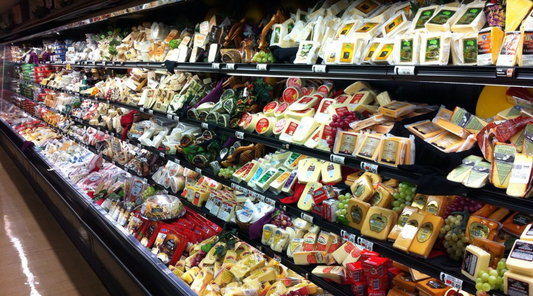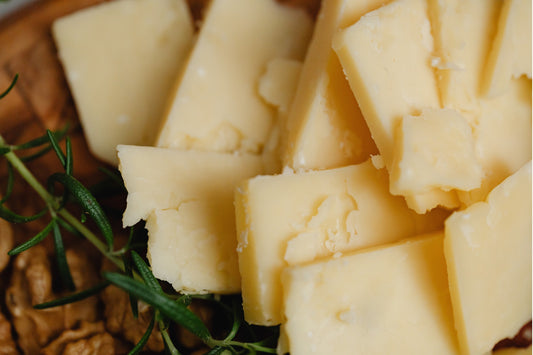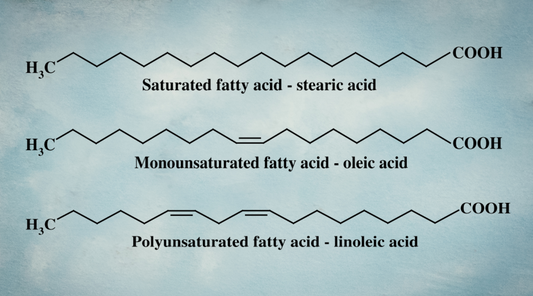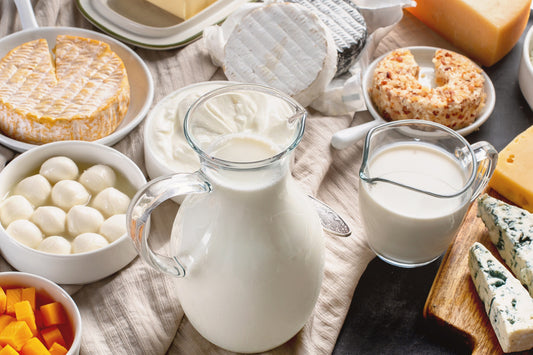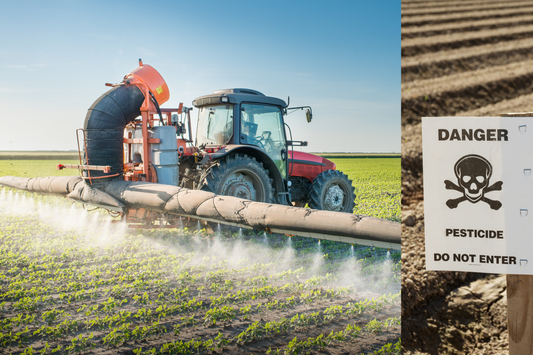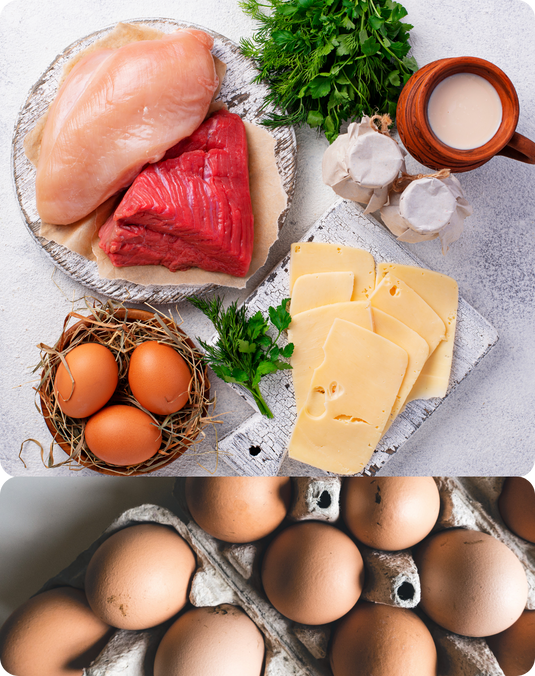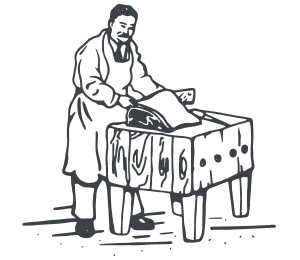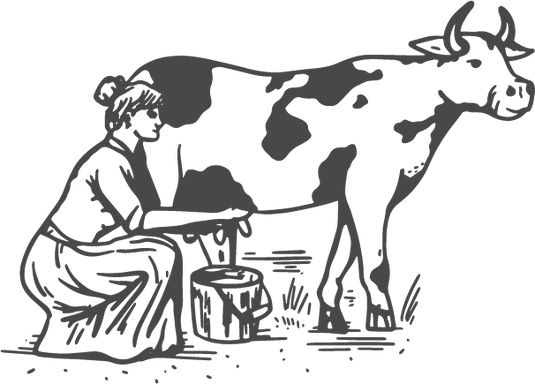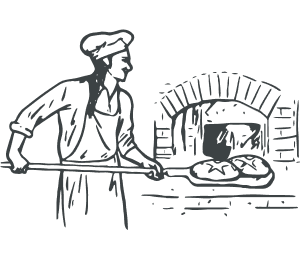
Grass-Fed vs. Grain-Fed Beef: The Metabolic Health Difference You Can See and Taste
Grain-fed cattle raised in feedlots aren’t just fatter… they show the same metabolic warning signs we associate with diabetes in humans.
In fact: the way a cow lives (what it eats, how it moves, and where it grazes) literally changes how its cells make energy.
You can even see the difference: grain-fed beef is typically paler in color and more heavily marbled with intramuscular fat. While that marbling is often celebrated as a mark of tenderness, in biological terms, it reflects poor metabolic health.
In this post, we’ll unpack the science behind how diet and living conditions shape metabolism in cattle, and why it matters for the meat on your plate.
ENERGY DIFFERENCE
The muscle tissue of grass-fed and grain-fed cattle differs not just in appearance, but in how it produces energy at the cellular level. Their cells run on two very different metabolic programs: grain-fed cattle rely more on glycolytic metabolism, while grass-fed cattle favor oxidative phosphorylation.
Let’s briefly unpack what that means and why it matters.
Every cell needs ATP, the body’s energy currency. There are two main ways to make it:
> Oxidative metabolism: the ideal, efficient process. Here, nutrients are fully burned in the mitochondria with oxygen, producing maximal ATP. After glycolysis, pyruvate enters the mitochondria and is completely oxidized via the TCA cycle and electron transport chain.
> Glycolytic metabolism: the less efficient shortcut. When mitochondria aren’t working well, or oxygen use is impaired, energy production stops after glycolysis. Pyruvate is converted into lactate instead of entering the mitochondria, generating only a fraction of the potential energy.
Think of it like a fire.
Glycolysis is like burning damp wood: it gives off some heat quickly but creates a lot of undesirable smoke and wastes most of the fuel.
Oxidative metabolism, on the other hand, is like burning dry wood in a well-ventilated fire: clean, hot, and efficient, using every bit of energy available.
Both systems run simultaneously to some degree, but when glycolysis dominates even in the presence of oxygen, it signals metabolic stress, a phenomenon first described by Otto Warburg in cancer cells. (ref)
In healthy cells with good mitochondrial function most cellular energy (ATP) is produced through oxidative metabolism: meaning glucose is fully burned in the mitochondria via the TCA cycle and electron transport chain. Lactate levels are low, because most pyruvate (from glycolysis) enters the mitochondria instead of being converted to lactate.
If mitochondria aren’t working efficiently (like in insulin resistance or diabetes) cells can’t oxidize glucose properly. As a result, glycolysis ramps up, and lactate production increases since pyruvate (from glycolysis) is converted to lactate instead of entering the mitochondria.
It is very well established in the literature that elevated blood lactate is considered a hallmark of insulin-resistant metabolism and diabetes, representing a shift from oxidative (efficient) energy production to glycolytic (inefficient) metabolism.
Decades of research show that elevated blood lactate is a hallmark of insulin-resistant metabolism and type 2 diabetes, reflecting a shift from oxidative to glycolytic energy production.
- Early metabolic studies show increased glycolysis with insulin resistance, even before diabetes fully develops. (ref)
- Individuals with higher blood lactate levels have a higher prevalence of metabolic-associated fatty liver disease (MAFLD) and insulin resistance. (ref)
This metabolic signature (high lactate, high glycolysis, low oxidative metabolism) marks a shift away from efficient energy production toward a stress-driven, metabolically hindered state.
THE RESEARCH
Research demonstrates that grain-fed cattle exhibit increased anaerobic glycolysis, evidenced by higher levels of pyruvate and lactate in their blood. (ref). In contrast, grass-fed cows have more oxidative muscle fibers, rich in mitochondria and myoglobin, which rely primarily on aerobic metabolism.
Enzyme activity further illustrates these differences. Grain-fed cattle show higher LDH and lower SDH, while grass-fed cattle display the opposite pattern.
- LDH (lactate dehydrogenase) is a key enzyme in anaerobic glycolysis. It allows glycolysis to continue when oxygen is limited, producing lactate as a byproduct.
- SDH (succinate dehydrogenase) operates exclusively in mitochondria and is a marker of robust oxidative metabolism.
High SDH activity (grass-fed in the figure below) indicates efficient fuel burning with oxygen, while low SDH and higher LDH (grain-fed in the figure below) reflects reduced mitochondrial function and a shift toward glycolysis.

Figures from (ref).
Another study found that feedlot-finished cattle had higher blood glucose and cortisol levels compared to pasture-raised cattle (ref), indicating metabolic stress and impaired health.
Metabolomic and gene expression analyses confirmed mitochondrial dysfunction and impaired oxidative phosphorylation in the muscle tissue of grain-fed animals.

Together, these findings show that the metabolic profile of grain-fed cattle mirrors the glycolytic, stress-like energy state associated with insulin resistance and diabetes.
IT MAKES SENSE
Grain-fed cattle are confined, fed a high-energy diet, and have very little opportunity to move. Their days consist almost entirely of eating, resting, and sleeping: conditions that predispose them to metabolic dysfunction.
(Imagine what would happen if you barely moved and ate a high-calorie, processed diet every day.)

Ruminants are naturally designed to graze freely and ruminate on pasture, following their instinctual behavior. Restricting these activities increases stress, which shows up in higher cortisol levels.
“The higher blood cortisol level in the grain-fed group strongly suggests that grass-fed animals experience less stress; mainly from moving freely, exercising their muscles, and expressing usual species behavior in a more natural environment” (ref)
This behavioral and environmental stress compounds the metabolic shifts we discussed earlier, creating a perfect storm of glycolytic energy metabolism, impaired mitochondrial function, and fat accumulation in grain-fed animals.
Cortisol, a well-studied stress hormone in humans, directly interferes with efficient energy production, promotes fat accumulation, and contributes to features of insulin resistance and metabolic disease (helping explain why confinement and high-calorie diets push grain-fed cattle into a metabolically stressed state.)
THE FAT DIFFERENCE
Both the type, composition, and total amount of fat in beef vary depending on whether cattle are grass-fed or grain-fed.
In humans, intramuscular fat (the equivalent of marbling in beef) is a hallmark of insulin resistance, impaired glucose metabolism, and mitochondrial dysfunction. When muscle cells can’t efficiently oxidize glucose or fat for energy, fat accumulates inside the fibers, reducing insulin sensitivity and metabolic health.
Yet in the beef world, we prize “marbling” (the intramuscular fat produced by high-grain feedlot diets).

In fact, metabolic dysfunction is rewarded: the USDA beef grading system classifies beef based on marbling.
- USDA Prime: the most marbled, tender, juicy, and “flavorful” beef, typically from young, grain-fed cattle.
- USDA Choice: slightly less marbling, still tender and flavorful; most grocery store beef falls here.
- USDA Select: leaner, less marbling, sometimes less tender or juicy.
Grass-fed beef can still be graded, but because these animals are leaner and have less intramuscular fat, it’s rare for grass-fed beef to reach Prime. Most grass-fed beef falls into Choice or Select.
While consumers have been trained to think more marbling = better quality, the USDA’s grading system rewards visual fat rather than biological health... and that’s worth questioning.
This grading system is unique to the United States. In most of Europe (like France, Ireland, the UK) cattle are traditionally raised on pasture, producing leaner, nutrient-rich, and mineral-forward beef.
Grass-fed beef is often leaner and metabolically healthier, though it scores lower in marbling-based grades.
Does that make grass-fed meat bad? No!
It’s the ancestral norm. Our ancestors ate naturally leaner ruminant meat. Wild ruminants were active, healthy, and metabolically normal: not overweight and inactive.
The highly marbled, grain-finished beef with a higher fat content common in U.S. feedlots is a modern innovation, a recent development in the history of beef.
I’m not demonizing beef fat. It has a great fatty acid profile and is rich in stearic acid, a metabolism supporting fatty acid!
But modern feedlot cattle are much fatter than wild ruminants because they are inactive and fed calorie-dense grains.
And there is some evidence suggesting that the fatty acid composition changes as well: grain-fed beef has fewer metabolism-supporting saturated fats and more PUFAs (ref), especially when fed distiller grains, a common feedlot ingredient in modern times.
- Feeding high levels of dried distillers grains with solubles (DDGS) to cattle resulted in a linear increase in polyunsaturated fatty acid (PUFA) content in beef (ref, ref)
- Feeding wet distillers grains plus solubles (WDGS) increased proportions of PUFA, omega-6 fatty acids, omega-6/omega-3 ratios, and trans fatty acids in beef compared to corn diets. (ref)

Yes, fat adds flavor.
But flavor isn’t only due to fat. Pasture diversity matters, too.
In France, this is called “terroir,” reflecting the grasses, clovers, and plants the animals grazed.
Modern conventional feedlot beef loses this complexity: cattle are confined, fattened on high-energy grain, and rarely exposed to diverse forage.
In fact, French chefs often describe U.S. beef as “too fatty, too soft, and too mild.”
While consumers have been trained to equate marbling with flavor and quality, it’s worth asking:
- Is that fat metabolically healthy?
- What does it say about the animal's diet and physiology?
- Were wild ruminants this fatty? (No)
- How does this affect the nutrient profile of the meat we eat beyond just vitamins and minerals?
Now, the idea that “grass-fed = no fat” is an oversimplification. Grass-fed beef on good pasture can have visible fat for juiciness, but it is leaner and metabolically healthier, with a different texture and flavor than high-marbling Prime beef.
Grazing cattle can develop healthy subcutaneous fat rather than heavy intramuscular marbling. Their active lifestyle burns calories and prevents metabolic dysfunction, while diverse forage provides plenty of nutrients for metabolically healthy fat deposition.
THE COLOR DIFFERENCE
Have you ever wondered why grass-fed beef is darker in appearance?
The answer lies in how the cow lived and what it ate—essentially, metabolically unwell cattle produce pale meat, while metabolically healthy cattle produce darker meat.
The deeper red color of grass-fed beef comes from higher oxidative metabolism, which results in more mitochondria and greater myoglobin content in the muscles. (ref).
Myoglobin, the red pigment that stores oxygen and supports efficient energy production, is higher in muscles with greater oxidative activity. These muscles also have more capillaries and stronger mitochondrial activity, reflected in higher cytochrome c oxidase expression, a key enzyme in the electron transport chain. Together, these features (abundant myoglobin, dense capillaries, and active mitochondria) give grass-fed beef its naturally deeper red color and reflect healthier, more oxidative muscle metabolism.

Figure from (ref).
Another contributor to the color difference is lactate concentration. Grain-fed cattle rely more on glycolytic metabolism, which produces more lactate in the muscle. After slaughter, this lactate accelerates the drop in pH, resulting in paler meat.
In contrast, grass-fed beef, with less lactate buildup and more oxidative metabolism, experiences a slower pH decline, maintaining a redder, darker color due to abundant myoglobin and mitochondrial density.

HUMAN COMPARISON
The metabolic profile of grain-fed, feedlot-finished beef mirrors features of human diabetes and metabolic disease, including:
- Mitochondrial dysfunction in muscle (ref)
-
Increased oxidative stress (ref)
-
Elevated blood glucose (ref)
-
Higher serum cortisol (ref)
- Fat accumulation inside muscle fiber ("marbling") is a hallmark sign of insulin resistance and diabetes (ref, ref)
In humans, fat accumulation inside muscle fibers is a hallmark of insulin resistance.
In cattle, it’s called “USDA Prime Grade.”
In contrast to feedlot cattle, the oxidative metabolism of pasture-raised, grass-fed animals resembles that of a healthy, athletic human phenotype, with efficient mitochondrial function, lower stress markers, and robust energy production.
CONCLUSIONS
In summary, grass-fed meat is metabolically healthier meat, reflecting both how the animal lived and how its tissues functioned. Active, pasture-raised cattle develop more oxidative, endurance-oriented muscle, while grain-fed, confined animals develop glycolytic muscle with characteristics similar to humans with diabetes and metabolic disease.
(But would you expect anything different when an animal is removed from nature, stuffed into a barn, barely moves with little exercise, and is fed high energy grain-based diets?)
With this line of reasoning, eating feedlot, grain-fed meat is, in essence, eating meat from animals with metabolic syndrome: stressed animals with elevated blood glucose, mitochondrial dysfunction, and impaired energy metabolism.
This outcome is not accidental… feedlot cattle are deliberately pushed into metabolic dysfunction through high-grain, PUFA-rich, energy-dense diets to fatten up quickly and create marbling, a visual marker of intramuscular fat accumulation driven by chronically elevated insulin and energy surplus.
The long-term consequences of consuming grain-fed, feedlot beef remain unclear, as industrial feedlot practices are a relatively recent development in human history. And very few studies have directly compared metabolic outcomes in humans consuming grain-fed versus regeneratively raised, pasture-fed beef.
Most existing research has focused on inflammation and lipid metabolism. For instance, in a randomized cross-over trial, Arya et al. (2010) (ref) found that participants consuming kangaroo meat from animals foraging on native pastures had significantly lower postprandial increases in IL-6, TNF-α, and CRP compared to those eating feedlot-finished beef. This suggests that meat from animals raised in their natural environment may promote a more favorable inflammatory profile.
Further clinical and nutritional studies are certainly needed to explore how the metabolic health of the animal translates to the metabolic health of the human consuming it.
Takeaway: Grass-fed, pasture-raised beef isn’t just leaner, it’s metabolically healthier, coming from animals that moved, grazed, and lived naturally. Grain-fed, feedlot beef, by contrast, comes from animals pushed into metabolic stress to produce marbling.
Choosing grass-fed meat means choosing meat from healthier animals, with muscle and fat composition that reflects their natural physiology, and a closer connection to how humans historically consumed ruminant meat.
Feedlot beef isn’t just raised differently... it functions differently, all the way down to the mitochondria.
Choosing 100% grass-fed, rotationally grazed beef means choosing meat from animals that lived and ate as nature intended, and that matters for your health too.
Shop 100% grass-fed, rotationally grazed beef today!





